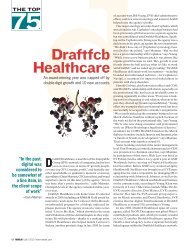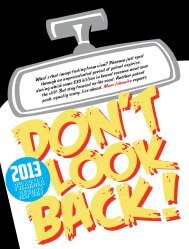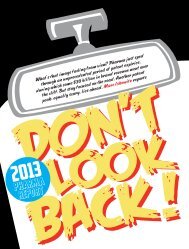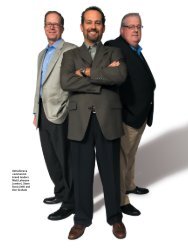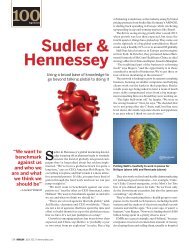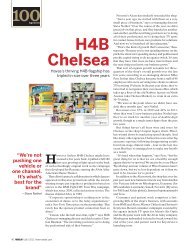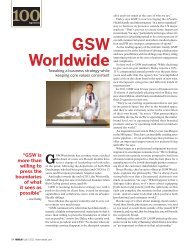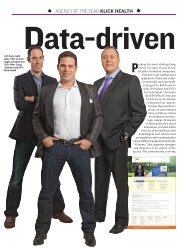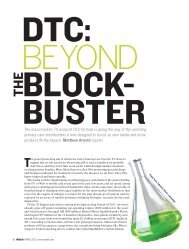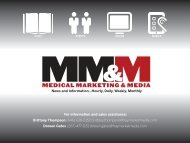Journal Ad Review - Medical Marketing and Media
Journal Ad Review - Medical Marketing and Media
Journal Ad Review - Medical Marketing and Media
Create successful ePaper yourself
Turn your PDF publications into a flip-book with our unique Google optimized e-Paper software.
PULP<br />
FRICTION<br />
<strong>Ad</strong> spend for medical/surgical journals declined<br />
by 16.5%, as a combination of patent expiries <strong>and</strong><br />
regulatory delays stifled 2011’s comeback bid.<br />
Marc Iskowitz reports on the numbers for the first<br />
half of 2012 by advertisers <strong>and</strong> br<strong>and</strong>s<br />
Professional journal advertising swung to a loss in the first half<br />
of 2012, from an 11.9% gain during the prior-year period. The<br />
decline means that print spending has faltered in its attempt<br />
to climb beyond recent highs, making a two-year-long rally which<br />
MM&M had characterized as one of “restrained recovery” now<br />
look more like restraint, plain <strong>and</strong> simple.<br />
In the first six months of this year, medical/surgical print spending<br />
took a 16.5% dive year-on-year, dropping to $168.2 million. On<br />
an ad-page basis, the decline was 20.1%. The greater healthcare<br />
market (which includes<br />
pharmacy, nurse practitioners/physicians<br />
assistants, managed care,<br />
etc.) registered a 13.9%<br />
JOURNAL AD REVIEW<br />
2012 MID-YEAR<br />
loss, coming in at $303.1 million, while pharmaceutical spending<br />
dropped 20.1% to $169.9 million. For the top 100 most advertised<br />
pharmaceuticals, outlays were decreased by a whopping 57% to<br />
$57.7 million.<br />
The main reason behind the print market’s softening is one that<br />
has become all too familiar: The number of new product launches<br />
is not big enough to fill the breach left by expiring drug patents<br />
<strong>and</strong> delayed approvals. There are a few specialty products on the<br />
horizon that could inject ad dollars, but no one expects a return<br />
to growth this year.<br />
At the journal level, multi-specialty titles were the loss leader.<br />
They were down 21.9% year-on-year, representing $14.5 million<br />
less in the market. Dollar growth vs. the year-ago period was confined<br />
to several niche sectors—healthcare business management,<br />
neurology <strong>and</strong> gastroenterology were the top-performing markets.<br />
Twenty-nine of the 37 markets that are tracked by Kantar <strong>Media</strong><br />
posted losses; among the doctor books, psychiatry, oncology <strong>and</strong><br />
rheumatology declined most steeply.<br />
TOP 5 MEDICAL/SURGICAL JOURNALS<br />
RANKED BY AD REVENUE, JAN-JUNE 2012<br />
1<br />
<strong>Journal</strong> of<br />
the American<br />
<strong>Medical</strong><br />
Association<br />
—ad pages<br />
down 40.5%<br />
vs. first-half<br />
2011<br />
3<br />
New<br />
American<br />
Family<br />
Physician<br />
—ad pages<br />
down 20.4%<br />
vs. first-half<br />
2011<br />
5 mmm-online.com<br />
Monthly<br />
Prescribing<br />
Reference—<br />
ad pages<br />
down 32.5%<br />
vs. first-half<br />
2011<br />
2<br />
Engl<strong>and</strong><br />
<strong>Journal</strong> of<br />
Medicine<br />
—ad pages<br />
down 41.7%<br />
vs. first-half<br />
2011<br />
4<br />
<strong>Medical</strong><br />
Economics<br />
—ad pages<br />
down 15.4%<br />
vs. first-half<br />
2011<br />
x SEPTEMBER 2012 x MM&M 41
JOURNAL AD REVIEW<br />
Publishers<br />
Each of the top five medical/surgical journals (ranked by revenue)<br />
registered a decrease in ad pages for the first half of 2012. The<br />
number-one journal in the field, Monthly Prescribing Reference<br />
shed about 269 ad pages, while the number-two <strong>Journal</strong> of the<br />
American <strong>Medical</strong> Association was down by 377. The New Engl<strong>and</strong><br />
<strong>Journal</strong> of Medicine thinned out by 645 ad pages, while American<br />
Family Physician was down by 137 pages <strong>and</strong> <strong>Medical</strong> Economics<br />
plunged 90.<br />
“Everyone was probably hoping for a little better beginning to<br />
the year,” acknowledged Mike Guire, director of commercial sales<br />
for Elsevier <strong>and</strong> president, Association of <strong>Medical</strong> <strong>Media</strong> (AMM).<br />
The decline “seems to be affecting all books in a similar manner, so<br />
I don’t think it’s any one thing.”<br />
With many of the traditionally big classes down (multi-specialty,<br />
IM <strong>and</strong> cardiology, for instance), print revenues sank across publishers’<br />
portfolios. Some publishers seem to be weathering the<br />
storm better than others—Slack is down by only 5% in revenue,<br />
Springer by a relatively small 9%—perhaps helped by their specialty<br />
publication focus.<br />
MOST ADVERTISED<br />
CATEGORY<br />
Antineoplastic agents became<br />
the most-advertised drug class<br />
during the first six months of<br />
2012, moving up from #2 during<br />
the year-ago period, despite<br />
a 15% decline in spending to<br />
$18.5 million. Bright spots<br />
included J&J prostate agent<br />
Zytiga, which upped ad outlays<br />
950% to $1.8 million, <strong>and</strong> some<br />
new <strong>and</strong> ongoing launches:<br />
Roche’s Erivedge for basal cell<br />
carcinoma <strong>and</strong> Zelboraf for<br />
melanoma, Seattle Genetics’<br />
<strong>Ad</strong>cetris for lymphoma <strong>and</strong><br />
Pfizer’s Xalkori for lung cancer.<br />
42 MM&M x SEPTEMBER 2012 x mmm-online.com<br />
<strong>Journal</strong> ad revenue, first half 2008-2012<br />
TOP 25 ADVERTISED CATEGORIES, JAN-JUNE 2012<br />
500<br />
400<br />
300<br />
200<br />
100<br />
0<br />
$403M<br />
Source: Kantar <strong>Media</strong><br />
$227M<br />
2008 2009 2010 2011 2012<br />
All Health Care <strong>Medical</strong>/Surgical<br />
Companies <strong>and</strong> Products<br />
The extent to which print has suffered can be seen in the company<br />
rankings. Forest remained the top print advertiser with a $22.1 million<br />
outlay, despite an 8.6% decrease vs. first-half 2011; Johnson & Johnson<br />
Rank Rank $ ad spending in thous<strong>and</strong>s % change<br />
2012 2011 Product 2012 2011 2010 2012 vs 2011 2011 vs 2010<br />
1 2 Antineoplastic Agents $18,540 $21,821 $21,652 -15.0% 0.8%<br />
2 1 SSRI/SNRI $12,430 $22,505 $19,084 -44.8% 17.9%<br />
3 14 Anticoagulants Oral $12,215 $3,034 $12 302.7% 24,502.6%<br />
4 3 Diabetes Insulin $10,185 $14,198 $13,933 -28.3% 1.9%<br />
5 35 Beta Agon, Oral Solids $7,608 $1,624 $0 368.4% N/A<br />
6 30 Seizure Disorders $4,853 $1,718 $5,518 182.5% -68.9%<br />
7 7 Non-Specific Promo <strong>Ad</strong>vert $3,323 $3,592 $3,915 -7.5% -8.3%<br />
8 0 Sedatives $3,072 $0 $0 N/A N/A<br />
9 13 Diabetes Oral $2,671 $3,066 $1,580 -12.9% 94.0%<br />
10 19 Dermatological, Other $2,632 $2,642 $2,151 -0.4% 22.8%<br />
11 11 Beta-Blocking Agents $2,576 $3,166 $3,522 -18.6% -10.1%<br />
12 10 Chol Red Rx Statins $2,520 $3,171 $3,084 -20.5% 2.8%<br />
13 42 Codeine & Comb Non-Inj. $2,429 $1,229 $1,303 97.7% -5.7%<br />
14 18 Biological Response Modifiers $2,394 $2,695 $2,597 -11.1% 3.8%<br />
15 4 Syn. Narcotic Analg. Non-Inj. $2,213 $7,950 $422 -72.2% 1,783.0%<br />
16 9 Antipsychotics Other $2,179 $3,487 $5,752 -37.5% -39.4%<br />
17 21 Interferon $2,014 $2,604 $1,627 -22.7% 60.1%<br />
18 16 Diuretics Non-Inj. $1,988 $2,937 $2,213 -32.3% 32.7%<br />
19 44 Neuro. Disord., Other $1,935 $1,130 $319 71.3% 254.4%<br />
20 5 Renin Angiotensin System Ant. $1,914 $5,740 $602 -66.7% 854.3%<br />
21 32 Antivirals, Other $1,909 $1,651 $1,166 15.6% 41.6%<br />
22 17 Alzheimer’s Type Dementia $1,635 $2,889 $3,725 -43.4% -22.4%<br />
23 24 Diabetes Therapy $1,621 $2,350 $1,686 -31.0% 39.4%<br />
24 165 Influenza Vaccine $1,420 $87 $98 1,523.6% -11.0%<br />
25 78 Diabetes Combinations $1,404 $570 $1,191 146.3% -52.2%<br />
Copyright 2012 Kantar <strong>Media</strong>. All rights reserved. Report <strong>and</strong> report data may not be reproduced or distributed outside of License company without the written permission of Kantar<br />
<strong>Media</strong>. See Market Opportunity Reporter ® Terms of Use for detailed information. Source: Kantar <strong>Media</strong>, <strong>Journal</strong> <strong>Ad</strong> <strong>Review</strong> Data, Report: I4<br />
$298M<br />
$157M<br />
$324M<br />
$180M<br />
$352M<br />
$201M<br />
$303M<br />
$168M
JOURNAL AD REVIEW<br />
moved up from fifth to second thanks to a $527,000 increase; <strong>and</strong><br />
Pfizer hovered in third place, notwithst<strong>and</strong>ing a 25.4% budget cut.<br />
Only two companies broke into the top 10 this year—GlaxoSmith-<br />
Kline <strong>and</strong> Purdue. Their 96.8% <strong>and</strong> 48.4% increases, respectively,<br />
knocked out Sanofi <strong>and</strong> Merck. The other six of 2012’s first-half top<br />
10 (Pfizer, Novo Nordisk, Novartis, Takeda, Lilly <strong>and</strong> Roche) severely<br />
curtailed print spend yet remained in the upper decile.<br />
The top 25 products accounted for 20% of all spend in the market,<br />
with $61.5 million (down by more than half vs. the first six months of<br />
last year). Forest has the top-advertised drug, antidepressant Viibryd,<br />
<strong>and</strong> four of the 10 most-advertised br<strong>and</strong>s. Viibryd, up from number<br />
11 last year thanks to a 173% push, <strong>and</strong> one other Forest drug<br />
enjoyed spending hikes, vs. a dial-back on fibromyalgia med Savella<br />
<strong>and</strong> BP product Bystolic. Among the top 25 br<strong>and</strong>s were seven newly<br />
advertised products, adding $18.2 million into the market.<br />
J&J hiked spend 6% to $8.9 million behind launches for prostate<br />
cancer drug Zytiga <strong>and</strong> blood thinner Xarelto. Those launches also<br />
helped propel the Antineoplastic Agents <strong>and</strong> Anticoagulants Oral<br />
classes to first <strong>and</strong> third place, respectively, on the list of most-advertised<br />
categories in the six months to June. Rounding out the top five<br />
classes by sales, the SSRI/SNRI <strong>and</strong> Diabetes Insulin classes—highly<br />
TOP 25 ADVERTISED BRANDS, JAN-JUNE 2012<br />
MOST ADVERTISED BRAND<br />
Forest’s SSRI Viibryd took first<br />
place, thanks to a 173% spending<br />
push during the Jan.-June period to<br />
$7.9 million, edging out J&J’s oral<br />
anticoagulant Xarelto, which had $6.7<br />
million in spend. Three other Forest<br />
br<strong>and</strong>s were in the top 10— Daliresp<br />
(COPD), Bystolic (hypertension) <strong>and</strong><br />
Savella (fibrolyalgia)—making Forest<br />
the period’s top advertiser. Purdue’s<br />
pain killers Intermezzo <strong>and</strong> Oxycontin<br />
had big outlays, as did Novo’s Victoza<br />
<strong>and</strong> Pfizer’s Lyrica.<br />
ranked the last several years—were also joined by Beta Agonists<br />
Oral, up from 35th place during first-half 2011.<br />
“There were 482 br<strong>and</strong>s that did journal advertising in first half of<br />
2011, versus 480 br<strong>and</strong>s in the same period in 2012,” observes Kelly<br />
Sborlini, VP of syndicated market research operations at Encuity<br />
Rank Rank $ ad spending in thous<strong>and</strong>s % change<br />
2012 2011 Product Company 2012 2011 2010 2012 vs 2011 2011 vs 2010<br />
1 11 Viibryd Forest $7,905 $2,894 $0 173.1% N/A<br />
2 — Xarelto tablets Johnson & Johnson $6,723 $0 $0 N/A N/A<br />
3 23 Daliresp Forest $5,610 $1,624 $0 245.4% N/A<br />
4 — Intermezzo sublingual Purdue $3,072 $0 $0 N/A N/A<br />
5 4 Savella tablets Forest $2,680 $4,620 $8,329 -42.0% -44.5%<br />
6 17 Victoza Novo Nordisk $2,450 $2,066 $1,489 18.6% 38.7<br />
7 36 Oxycontin Purdue $2,423 $1,193 $1,303 103.1% -8.4%<br />
8 8 Bystolic Forest $2,376 $3,166 $3,504 -25.0% -9.6%<br />
9 54 Lyrica Pfizer $2,063 $863 $3,321 138.9% -74.0%<br />
10 — Daliresp NB Forest $1,998 $0 $0 N/A N/A<br />
11 — Edarbyclor tablets Takeda $1,986 $0 $0 N/A N/A<br />
12 — Brilinta tablets AstraZeneca $1,936 $0 $0 N/A N/A<br />
13 2 Teflaro injection Forest $1,906 $5,068 $0 -62.4% N/A<br />
14 239 Zytiga Johnson & Johnson $1,801 $171 $0 950.9% N/A<br />
15 — Bydureon Amylin $1,696 $0 $0 N/A N/A<br />
16 6 Butrans Purdue $1,657 $3,582 $0 -53.8% N/A<br />
17 56 Byetta Amylin/Lilly $1,642 $839 $2,035 95.7% -58.8%<br />
18 18 Namenda Forest $1,603 $2,021 $2,483 -20.7% -18.6%<br />
19 41 Humira Abbott $1,594 $1,127 $0 41.4% N/A<br />
20 15 Samsca tablets Otsuka $1,582 $2,235 $2,213 -29.2% 1.0<br />
21 10 Pradaxa Boehringer Ingelheim $1,497 $2,910 $0 -48.5% N/A<br />
22 220 Tradjenta Boehringer/Lilly $1,450 $197 $0 635.9% N/A<br />
23 16 Latuda Sunovion $1,301 $2,213 $0 -41.2% N/A<br />
24 21 Forteo Eli Lilly $1,271 $1,825 $0 -30.3% N/A<br />
25 — Janumet XR Merck $1,258 $0 $0 N/A N/A<br />
Copyright 2012 Kantar <strong>Media</strong>. All rights reserved. Report <strong>and</strong> report data may not be reproduced or distributed outside of License company without the written permission of Kantar <strong>Media</strong>. See Market Opportunity Reporter ®Terms of Use for detailed<br />
information.Source: Kantar <strong>Media</strong>, <strong>Journal</strong> <strong>Ad</strong> <strong>Review</strong> Data, Report: I4<br />
mmm-online.com x SEPTEMBER 2012 x MM&M 43
JOURNAL AD REVIEW<br />
TOP 10 ONLINE BRANDS, JAN-JUNE 2012<br />
Br<strong>and</strong>s ranked by frequency of ad occurrences<br />
Rank<br />
2012 Br<strong>and</strong>/Manufacturer % of all occurances<br />
1 Recothrom (ZymoGenetics) 4.5%<br />
2 Axiron (Eli Lilly) 4.3%<br />
3 ProAir HFA (Teva) 3.5%<br />
4 Oracea (Galderma) 3.4%<br />
5 Provenge (Dendreon) 3.2%<br />
6 Daliresp (Forest) 2.8%<br />
7 Bydureon (Amylin) 2.6%<br />
8 Xarelto (Johnson & Johnson) 2.6%<br />
9 Victoza (Novo Nordisk) 2.5%<br />
10 Erivedge (Roche) 2.4%<br />
Copyright 2012 Kantar <strong>Media</strong>, Evaliant.<br />
Research. “However, the average spend per br<strong>and</strong> in the first half<br />
of the year decreased by about $40,000 from $324,000 in 2011 to<br />
$281,000 in 2012,” her firm’s data show.<br />
Online<br />
There does seem to be a silver lining for journal publishers, <strong>and</strong> it’s<br />
the growth of digital advertising. As digital spend is not captured in<br />
the conventional tracking services, MM&M asked whether online<br />
advertising is up <strong>and</strong> how else revenue sources are diversifying.<br />
Consensus among a number of AMM members, according to Guire,<br />
is that they are experiencing revenue gains in newer media channels<br />
like on-site advertising, microsites <strong>and</strong> e-blasts, licensing, events <strong>and</strong><br />
digital broadcasts. Another growth area has been ads on iPad apps.<br />
Wolters Kluwer says its Lippincott Williams <strong>and</strong> Wilkins (LWW)<br />
titles have mitigated print losses, <strong>and</strong> boosted digital revenues, after<br />
the publisher stopped offering advertisers the option of print-only<br />
ads. Print <strong>and</strong> digital apps are sold together at one price.<br />
First-half print revenue for the LWW journals declined by 10.8%<br />
vs. the year-ago period. By contrast, Elsevier revenues fell 18%,<br />
<strong>Ad</strong>vanstar 17% <strong>and</strong> the American <strong>Medical</strong> Association 25%. “When<br />
we look at revenue at the macro level,” says Karen Abramson,<br />
44 MM&M x SEPTEMBER 2012 x mmm-online.com<br />
SEEN ON THE MOST SITES<br />
The #3 print br<strong>and</strong>, J&J blood thinner<br />
Xarelto, was the most widely advertised<br />
br<strong>and</strong> on sites tracked by Kantar’s<br />
Evaliant tool <strong>and</strong> #8 in terms of<br />
online occurrences. Two Lilly br<strong>and</strong>s—<br />
testosterone treatment Axiron <strong>and</strong><br />
antidepressant Cymbalta—trailed at<br />
#2 <strong>and</strong> #3. Neither was a top 100<br />
print advertiser, but other top 100<br />
print br<strong>and</strong>s do appear among the top<br />
online br<strong>and</strong>s (based on insertions),<br />
including Novo’s Victoza, Gilead’s<br />
Complera <strong>and</strong> Pfizer’s Prevnar.<br />
TOP 10 ONLINE BRANDS, JAN-JUNE 2012<br />
Br<strong>and</strong>s ranked by quantity of sites used<br />
Rank<br />
2012 Br<strong>and</strong>/Manufacturer # of sites used<br />
1 Xarelto (Johnson & Johnson) 32<br />
2 Axiron (Eli Lilly) 29<br />
3 Cymbalta (Eli Lilly) 25<br />
4 Victoza (Novo Nordisk) 24<br />
5 Creon (Abbott) 19<br />
6 Complera (Gilead) 18<br />
7 Prevnar (Pfizer) 17<br />
8 Byetta (Amylin) 17<br />
9 Nucynta (Johnson & Johnson) 16<br />
10 Brilinta (AstraZeneca) 16<br />
Copyright 2012 Kantar <strong>Media</strong>, Evaliant.<br />
president <strong>and</strong> CEO of Wolters Kluwer Health <strong>Medical</strong> Research,<br />
“we’re outperforming the market <strong>and</strong> we attribute this lift in part<br />
to the bundled ad model we introduced in January.”<br />
Meanwhile, Kantar’s Evaliant data show br<strong>and</strong> managers may<br />
be getting smarter about using multiple platforms to reach their<br />
audiences. Nine of the top 10 print advertisers (based on number of<br />
insertions) also show up in the top 30 companies online (based on<br />
occurrences), with most falling in the top 20. Forest, the biggest print<br />
advertiser, ranked 11th in online occurrences. That’s a big improvement<br />
over last year at this time, when the drugmaker had no presence<br />
on the major websites tracked by Evaliant (Forest could have been<br />
engaging in other types of online promotion, such as e-detailing,<br />
e-sampling or microsites). Four firms were in the top 10 both in print<br />
<strong>and</strong> online: Pfizer, J&J, Novartis <strong>and</strong> Roche, vs. two last year.<br />
At the br<strong>and</strong> level, several top online br<strong>and</strong>s (based on occurrences)<br />
aren’t in the top 100 print br<strong>and</strong>s (based on insertions), <strong>and</strong> vice versa.<br />
Only Daliresp (number six online, two in print) <strong>and</strong> Xarelto (number<br />
eight online, three in print) hit the top 10 in both media. Many of the<br />
most widely advertised br<strong>and</strong>s (those using the most sites) were, not<br />
surprisingly, also among the top in occurrences.<br />
The future<br />
In this era when more clinicians use portable devices to consume<br />
professional journal content, <strong>and</strong> pharma advertisers are allocating<br />
promotional spend between many channels, it might be unrealistic to<br />
think journal ad spend will move any direction but sideways. On the<br />
other h<strong>and</strong>, IMS Health’s Global Use of Medicines Outlook report<br />
predicts that drug approvals—the main driver of promotion—will<br />
improve <strong>and</strong> that pharma will launch 30-something NMEs each year<br />
through 2016. Will that help print stage a sustained comeback?<br />
Says Wolters Kluwer’s Abramson, any return to R&D productivity<br />
must be viewed against the backdrop of shrinking pipelines for<br />
blockbuster products <strong>and</strong> pharma’s shift to deliver more niche drugs.<br />
“When you define print journal pages as advertising, then yes, we’ll<br />
continue to see a decline <strong>and</strong> fluctuations,” she predicts. “But today,<br />
we need to look at this industry in a positive transformation that’s<br />
defined by the audience reach across multiple channels.” n



